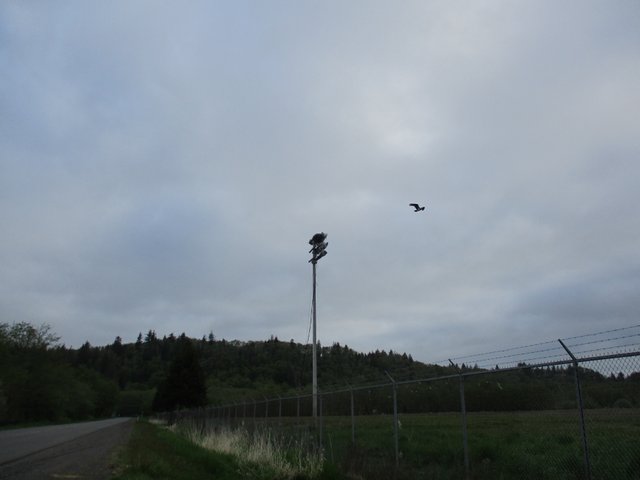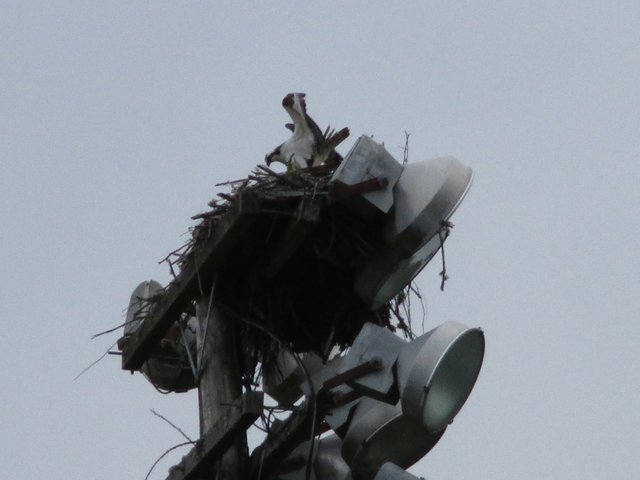.jpg)
There is an osprey nest on the edge of the Grays Harbor National Wildlife Refuge, located just west of my hometown of Hoquiam, Wash.
I discovered the nest on an early morning walk Friday. We are in the midst of shorebird migration season, which lasts from late April to early May. Hundreds of thousands of shorebirds migrate through the 94-square-mile Grays Harbor estuary, one of six major estuaries on the Pacific Coast, and the 1,500-acre refuge has been set aside for their use.
The refuge is a prime gathering place for shorebirds. The birds feed on invertebrates in mudflats along intertidal waters, and the mudflats in the refuge are the first to be exposed in the Grays Harbor estuary when the tide goes out, and the last to be covered when it rises. There is also a salt marsh and thickets where the birds can hide out at high tide.
High tide is the best time to see the birds, because the water level pushes them closer to the roughly half-mile boardwalk that runs through the woods to the edge of the mudflats. High tide Friday morning was around 6:20 a.m., near dawn.
.jpg)
I’m new to tidal regions, and I only recently learned that high tide can occur twice in a day, and that it rises to different levels. Friday morning’s high tide did not completely cover the mudflats, so the birds I found in the refuge then were still a fair distance away. This photo gives a sense of the size of the flock though.
.jpg)
The woods and thickets also play host to migrating songbirds. A symphony was playing all along my three- or four-mile walk to the refuge. I didn’t see many of the players, but I did record a sample, from the boardwalk in the refuge.
Even though the shorebirds were beyond range of my camera, it was beautiful to watch them across the vast space. This particular species (there are about two dozen species that use the refuge) is brown on top and white underneath, and as the flock wheeled to new positions on the mudflats, it would flash in a ripple from dark to light.
The Nest
On my way back to town along Paulson Road, I walked underneath the osprey nest, which is on top a light pole. I would have missed it, but I heard a rather loud call. I looked up just in time to see one of two adult ospreys leave the nest and head out toward the mudflats. The other one stayed behind and kept an eye on me.
We'll call them the hunter and the guard.
There’s a fire hydrant about 50 feet from the base of the light pole. I was able to set my 10-inch tripod on there to shoot the video and most of the photos. It also served as a bird blind once I had crouched down behind it (until I stretched my legs and got spotted again).
After a while, the hunter returned with a catch. Just before it arrived, the guard left the nest. It didn’t go far, just wheeled around out of the way of the returning hunter, as though giving it room to land.
%20-%20Copy.jpg)
I couldn’t see what was in the hunter’s claws: probably a fish, since 99 percent of an osprey’s diet is fish, and it was returning from the direction of the water. I couldn’t see if there are any babies either, but I got a few shots of it dropping off its bounty.
.jpg)
.jpg)
Then it took off again, and the guard settled in to keep on eye on me. I headed home soon after that.
About a mile farther on my way, I spotted the hunter circling over a clearing in the woods. I had the camera in my pocket at that point, and at first I wasn’t sure what was going to happen, so I didn’t get a pic of this.
The osprey floated very slowly over the clearing, came to stop and hovered. It folded its wings above it – like a person holding their arms over their head with bent elbows, except the wings bent the other way – then dropped straight down, claws extended beneath it. It was a controlled, slow drop, something like a helicopter landing, or a parachutist. About halfway down it extended its wings a little, almost pausing in air for a nanosecond, and made a few adjustments to its position. Then it resumed the drop, picking up speed as it neared the ground and disappeared in the brush.
About a second or two later, it reappeared heading back toward the nest, with a rodent of some sort in its claws.
While preparing this post, I learned that osprey also catch fish by hovering.
That would be something to see. I’ll definitely be keeping an eye out whenever I’m walking along the Harbor from now on!
.jpg)


Congratulations @cliffagreen! You have completed the following achievement on the Steem blockchain and have been rewarded with new badge(s) :
You can view your badges on your Steem Board and compare to others on the Steem Ranking
If you no longer want to receive notifications, reply to this comment with the word
STOPTo support your work, I also upvoted your post!
Vote for @Steemitboard as a witness to get one more award and increased upvotes!
Downvoting a post can decrease pending rewards and make it less visible. Common reasons:
Submit